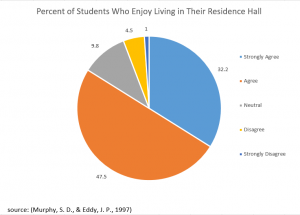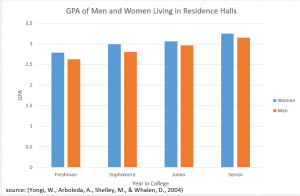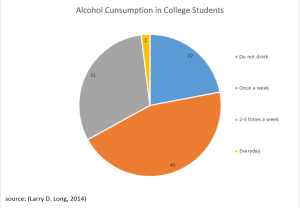A college student’s future success can be influenced by the living conditions and resources offered within their residence hall. It is necessary for universities pay attention to these conditions to help their students have more success in the future. Men and women perform differently throughout their college career and their concerns and problems could be different. Because of this, their problems and concerns should be addressed differently. Universities could split up men and women some in residence halls so they can be around other students who may have the same concerns as them. Some universities have programs within their residence halls called learning communities that may help improve the success of students. Universities should make sure these programs have a positive effect on students. They could consider implementing a dyad concept to help students reach their academic goals. Students living in sororities and fraternities may not be as successful as those living within residence halls. Universities could consider making students wait to join a sorority or fraternity. This would give the students time to mature a bit more before they are in a house without any supervision. Just a few small changes within residence halls could greatly impact the success of students who live within them. For more information on this topic go to https://u.osu.edu/sp16esepsy1359/2016/04/25/final-presentation/.
Author: booth.263
Final Presentation
Draft
Process as Product (Jing)
3-5 Graphics
Outline w/ 2 arguments
- Introduction
- Thesis: The living conditions and resources offered within residence halls can have an effect on the student and their future success. It is important that universities pay attention to these conditions to help their students be successful.
- Argument 3 summarized- Learning communities may not actually effect the success of students.
- Argument 2 summarized- Students living in residence halls are more likely to be successful than those living in a fraternity or sorority.
- Argument 1 summarized
- Restate thesis.
- Argument 3- Learning communities may not actually effect the success of students and should be incorporated into each residence hall.
- “Some studies of L/L programs have determined that students find greater friendliness and warmth in their environments than do those in non-L/L residence halls” (Longerbeam, Inkelas, & Brower, 2007).
- “There were no significant differences between students living in L/L buildings and those not in L/L buildings on their intellectual growth or their use on consequences of alcohol. In general, the data did not reveal differences on academic and alcohol outcomes between students living in residence halls with a larger L/L program presence and students living in residence halls with lesser or no L/L program presence.” (Longerbeam, Inkelas, & Brower, 2007)
- “studies of L/L programs have found that students who participate in L/L programs experience better adjustment to college than do those in non-L/L residence halls” (Longerbeam, Inkelas, & Brower, 2007).
- This is a study different from the one done by Longerbeam, Inkelas, and Brower. This study was done by Pascarella and Terenzini in 1991 and in 2005.
- Even though there may be a better adjustment to college, there were no other differences in outcomes between learning community and non-learning community environments. This was determined in a study by Lacy in 1978.
- “Pike concluded that L/L programs alone do not promote gains in intellectual development, but more likely contribute to intellectual growth indirectly through interaction.” (Longerbeam, Inkelas, & Brower, 2007)
- This was from a study done by Pike in 1999.
- L/L programs may not actually be what is helping these students grow intellectually.
- Appears “that the L/L buildings foster an overall sense of social support. This study’s findings also support Pike’s (1999) speculation that L/L program effects work indirectly on students through their enhanced interactions and involvement with each other” (Longerbeam, Inkelas, & Brower, 2007)
- According to housing.osu.edu, learning communities offer direct connection to the classroom experience and staff members that are dedicated to make sure students are successful.
- It seems that the staff members within non learning community residence hall offer a lot of support to the students as well. They monitor their behavior and offer to help keep them on track.
- It seems like it’s up the student whether or not they want to take advantage of the resources on campus to help them be successful.
- “Perceptions of students are positively enhanced when dyads are implemented in residence hall programming and training” (Murphy and Eddy, 1997).
- “The dyad concept places two students in a position to work together to achieve predetermined goals and objectives within each resident hall wing” (Murphy and Eddy, 1997).
- This could be implemented in all dorms and then all students could benefit from the goals set.
- Conclusion: Learning communities do not have a major impact on the success of students but could be incorporated into each residence hall so that all students can have an equal opportunity to be successful.
- Argument 2- Students living in residence halls are more likely to be successful than those living in a fraternity or sorority.
- The students living within residence halls are more satisfied with their living conditions.
- more safe
- More secure
- Students living in residence halls have a higher GPA than students living in fraternities or sororities.
- Students living in sororities/ fraternities are more likely to binge drink and consume alcohol more frequently.
- Students living in sororities/ fraternities had greater satisfaction with the programming provided to them.
- This is probably because they “are generally responsible organizing the programs that are offered in their organizations”
- Including students in their planning of their programs can “positively influence residence satisfaction”. This could be incorporated in residence halls to improve their satisfaction with programming.
- Sororities have a “reported a higher degree of peer interaction” but residence halls could do more to encourage active engagement.
- Conclusion: It is better for students to live in residence halls than in sororities/ fraternities.
- The students living within residence halls are more satisfied with their living conditions.
- Argument 3- Boys and girls should be mixed in residence halls??
- Conclusion
- Thesis: The living conditions and resources offered within residence halls can have an effect on the student and their future success. It is important that universities pay attention to these conditions to help their students be successful.
- Argument 3 summarized- Learning communities may not actually effect the success of students.
- Argument 2 summarized- Students living in residence halls are more likely to be successful than those living in a fraternity or sorority.
- Argument 1 summarized.
- Restate Thesis.
ToDo List for class 5
- Outline with 2 arguments
- Read chapters 7 and 8
- “Process as Product” document
- Read and Critique group members outlines
- Find 3-5 graphics
1 or 2 Arguments (draft)
- Student living in residences halls are more likely to be successful than those living in a fraternity or sorority.
- Learning communities do not actually change the success of students very much.
3 more sources
Murphy, S., & Eddy, J. (1997). College resident halls research study: Student perceptions of resident assistants, fellow… College Student Journal. 31(1), 110.
Zhiri, N. (2012). Designed for Success. American School & University, 84(12), 128-130.
The positive and negative effects of first-year learning communities. (2006). Academic Leader, 22(11), 7-8.
Annotated Bibliography (4)
Yongyi, W., Arboleda, A., Shelley II, M., & Whalen, D. (2004). The influence of residence hall community academic success of male and female undergraduate students. Journal of College and University Student Housing, 33(1), 16-22.
This article shows the results of a study done to see the effect gender and residence hall living has on the success of students. This was written by Wang Yongyi, Ana Arboleda, Mack C. Shelly II, and Donald F. Whalen. Each of them are affiliated with Iowa State University which means they should have been able to get a wide range of students to study. One of the things I wanted to look into, is how different genders in residence halls can affect the students which is what this article covers. This article was published in 2004 so it is a little bit older but the effects then should still be similar to the effects now. I used the academic search complete database to find this article. Using the Boolean operators, I searched “residence halls NOT alcohol” to find this article.


